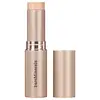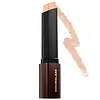bareMinerals Complexion Rescue Hydrating Foundation SPF 25 Versus Hourglass Cosmetics Hourglass Vanish Seamless Foundation Stick
What's inside
What's inside
 Key Ingredients
Key Ingredients

 Benefits
Benefits

 Concerns
Concerns

 Ingredients Side-by-side
Ingredients Side-by-side

Titanium Dioxide
Cosmetic ColorantSea Water
HumectantWater
Skin ConditioningCoconut Alkanes
EmollientSqualane
EmollientParaffin
PerfumingNeopentyl Glycol Diheptanoate
EmollientGlycerin
HumectantBis-Butyldimethicone Polyglyceryl-3
CleansingJojoba Esters
EmollientLauryl PEG-9 Polydimethylsiloxyethyl Dimethicone
Skin ConditioningSaccharomyces/Xylinum/Black Tea Ferment
Skin ConditioningIsostearic Acid
CleansingPolymethylsilsesquioxane
Dimethicone
EmollientTrifluoropropyldimethyl/Trimethylsiloxysilicate
EmollientTrehalose
HumectantMoringa Oleifera Seed Extract
Skin ConditioningCamellia Japonica Flower Extract
EmollientSalicornia Herbacea Extract
Skin ConditioningTheobroma Cacao Seed Extract
AntioxidantDisodium Stearoyl Glutamate
CleansingSea Salt
AbrasiveBiosaccharide Gum-4
Skin ConditioningPalmitoyl Tripeptide-5
Skin ConditioningPEG-12 Dimethicone
Skin ConditioningCaprylic/Capric Triglyceride
MaskingLauroyl Lysine
Skin ConditioningCoco-Caprylate/Caprate
EmollientButylene Glycol
HumectantEthylhexylglycerin
Skin ConditioningTocopherol
AntioxidantSilica
AbrasiveAluminum Hydroxide
EmollientDisteardimonium Hectorite
StabilisingMicrocrystalline Wax
Emulsion StabilisingPropanediol
SolventSodium Chloride
MaskingSodium Carrageenan
Emulsion StabilisingStearic Acid
CleansingTrisodium EDTA
Aluminum Dimyristate
Emulsion StabilisingTriethoxycaprylylsilane
1,2-Hexanediol
Skin ConditioningBoron Nitride
AbsorbentDisodium Phosphate
BufferingCitric Acid
BufferingBHT
AntioxidantPotassium Sorbate
PreservativeSodium Benzoate
MaskingPhenoxyethanol
PreservativeIron Oxides
Titanium Dioxide, Sea Water, Water, Coconut Alkanes, Squalane, Paraffin, Neopentyl Glycol Diheptanoate, Glycerin, Bis-Butyldimethicone Polyglyceryl-3, Jojoba Esters, Lauryl PEG-9 Polydimethylsiloxyethyl Dimethicone, Saccharomyces/Xylinum/Black Tea Ferment, Isostearic Acid, Polymethylsilsesquioxane, Dimethicone, Trifluoropropyldimethyl/Trimethylsiloxysilicate, Trehalose, Moringa Oleifera Seed Extract, Camellia Japonica Flower Extract, Salicornia Herbacea Extract, Theobroma Cacao Seed Extract, Disodium Stearoyl Glutamate, Sea Salt, Biosaccharide Gum-4, Palmitoyl Tripeptide-5, PEG-12 Dimethicone, Caprylic/Capric Triglyceride, Lauroyl Lysine, Coco-Caprylate/Caprate, Butylene Glycol, Ethylhexylglycerin, Tocopherol, Silica, Aluminum Hydroxide, Disteardimonium Hectorite, Microcrystalline Wax, Propanediol, Sodium Chloride, Sodium Carrageenan, Stearic Acid, Trisodium EDTA, Aluminum Dimyristate, Triethoxycaprylylsilane, 1,2-Hexanediol, Boron Nitride, Disodium Phosphate, Citric Acid, BHT, Potassium Sorbate, Sodium Benzoate, Phenoxyethanol, Iron Oxides
Phenyl Trimethicone
Skin ConditioningC12-15 Alkyl Ethylhexanoate
EmollientCaprylic/Capric Triglyceride
MaskingEthylhexyl Methoxycinnamate
UV AbsorberEuphorbia Cerifera Wax
Ceresin
Emulsion StabilisingPolyethylene
AbrasivePentylene Glycol
Skin ConditioningMicrocrystalline Wax
Emulsion StabilisingPolyglyceryl-2 Triisostearate
EmulsifyingVp/Hexadecene Copolymer
Methyl Methacrylate Crosspolymer
1,2-Hexanediol
Skin ConditioningAluminum Hydroxide
EmollientBHT
AntioxidantCaprylyl Glycol
EmollientDimethicone
EmollientEthylhexylglycerin
Skin ConditioningIllicium Verum Fruit Extract
PerfumingIsostearyl Alcohol
EmollientLauryl Laurate
Skin ConditioningLauryl PEG/PPG-18/18 Methicone
Skin ConditioningMacadamia Seed Oil Polyglyceryl-6 Esters Behenate
EmollientMethicone
EmollientMica
Cosmetic ColorantPhenoxyethanol
PreservativePropanediol
SolventSilica
AbrasiveTalc
AbrasiveTriethoxycaprylylsilane
Iron Oxides
CI 77891
Cosmetic ColorantPhenyl Trimethicone, C12-15 Alkyl Ethylhexanoate, Caprylic/Capric Triglyceride, Ethylhexyl Methoxycinnamate, Euphorbia Cerifera Wax, Ceresin, Polyethylene, Pentylene Glycol, Microcrystalline Wax, Polyglyceryl-2 Triisostearate, Vp/Hexadecene Copolymer, Methyl Methacrylate Crosspolymer, 1,2-Hexanediol, Aluminum Hydroxide, BHT, Caprylyl Glycol, Dimethicone, Ethylhexylglycerin, Illicium Verum Fruit Extract, Isostearyl Alcohol, Lauryl Laurate, Lauryl PEG/PPG-18/18 Methicone, Macadamia Seed Oil Polyglyceryl-6 Esters Behenate, Methicone, Mica, Phenoxyethanol, Propanediol, Silica, Talc, Triethoxycaprylylsilane, Iron Oxides, CI 77891
Ingredients Explained
These ingredients are found in both products.
Ingredients higher up in an ingredient list are typically present in a larger amount.
1,2-Hexanediol is a synthetic liquid and another multi-functional powerhouse.
It is a:
- Humectant, drawing moisture into the skin
- Emollient, helping to soften skin
- Solvent, dispersing and stabilizing formulas
- Preservative booster, enhancing the antimicrobial activity of other preservatives
Aluminum Hydroxide is a form of aluminum. It can be naturally found in nature as the mineral gibbsite. In cosmetics, Aluminum Hydroxide is used as a colorant, pH adjuster, and absorbent.
As a colorant, Aluminum Hydroxide may add opacity, or reduce the transparency. Aluminum hydroxide is contains both basic and acidic properties.
According to manufacturers, this ingredient is an emollient and humectant. This means it helps hydrate the skin.
In medicine, this ingredient is used to help relieve heartburn and help heal ulcers.
There is currently no credible scientific evidence linking aluminum hydroxide in cosmetics to increased cancer risk.
Major health organizations allow the use of aluminum hydroxide in personal care products and have not flagged it as a carcinogenic risk at typical usage levels.
Learn more about Aluminum HydroxideBHT is a synthetic antioxidant and preservative.
As an antioxidant, it helps your body fight off free-radicals. Free-radicals are molecules that may damage your skin cells.
As a preservative, it is used to stabilize products and prevent them from degrading. Specifically, BHT prevents degradation from oxidation.
The concerns related to BHT come from oral studies; this ingredient is currently allowed for use by both the FDA and EU.
However, it was recently restricted for use in the UK as of April 2024.
Learn more about BHTThis ingredient is an emollient, solvent, and texture enhancer. It is considered a skin-softener by helping the skin prevent moisture loss.
It helps thicken a product's formula and makes it easier to spread by dissolving clumping compounds.
Caprylic Triglyceride is made by combining glycerin with coconut oil, forming a clear liquid.
While there is an assumption Caprylic Triglyceride can clog pores due to it being derived from coconut oil, there is no research supporting this.
Learn more about Caprylic/Capric TriglycerideDimethicone is a type of synthetic silicone created from natural materials such as quartz.
What it does:
Dimethicone comes in different viscosities:
Depending on the viscosity, dimethicone has different properties.
Ingredients lists don't always show which type is used, so we recommend reaching out to the brand if you have questions about the viscosity.
This ingredient is unlikely to cause irritation because it does not get absorbed into skin. However, people with silicone allergies should be careful about using this ingredient.
Note: Dimethicone may contribute to pilling. This is because it is not oil or water soluble, so pilling may occur when layered with products. When mixed with heavy oils in a formula, the outcome is also quite greasy.
Learn more about DimethiconeEthylhexylglycerin (we can't pronounce this either) is commonly used as a preservative and skin softener. It is derived from glyceryl.
You might see Ethylhexylglycerin often paired with other preservatives such as phenoxyethanol. Ethylhexylglycerin has been found to increase the effectiveness of these other preservatives.
Microcrystalline Wax is created by de-oiling petroleum. It is highly refined and purified before being added to cosmetics.
Microcrystalline Wax is used to enhance the texture and create even consistency. It helps stabilize a product by preventing ingredients from separating.
Phenoxyethanol is a preservative that has germicide, antimicrobial, and aromatic properties. Studies show that phenoxyethanol can prevent microbial growth. By itself, it has a scent that is similar to that of a rose.
It's often used in formulations along with Caprylyl Glycol to preserve the shelf life of products.
Propanediol is an all-star ingredient. It softens, hydrates, and smooths the skin.
It’s often used to:
Propanediol is not likely to cause sensitivity and considered safe to use. It is derived from corn or petroleum with a clear color and no scent.
Learn more about PropanediolSilica, also known as silicon dioxide, is a naturally occurring mineral. It is used as a fine, spherical, and porous powder in cosmetics.
Though it has exfoliant properties, the function of silica varies depending on the product.
The unique structure of silica enhances the spreadability and adds smoothness, making it a great texture enhancer.
It is also used as an active carrier, emulsifier, and mattifier due to its ability to absorb excess oil.
In some products, tiny microneedles called spicules are made from silica or hydrolyzed sponge. When you rub them in, they lightly polish away dead skin layers and enhance the penetration of active ingredients.
Learn more about SilicaTriethoxycaprylylsilane is a silicone used to bind and stabilize ingredients.
As an emulsifier, it helps prevent ingredients from separating. This can help elongate the shelf life of products.
Triethoxycaprylylsilane is often used to coat mineral sunscreens ingredients to help give a better feel. It also helps reduce oxidative stress in sunscreens.
Learn more about TriethoxycaprylylsilaneThis ingredient is a combination of red, black, and yellow iron oxide pigments. This combination of colors is usually found in foundation, because it results in a "skin" color.